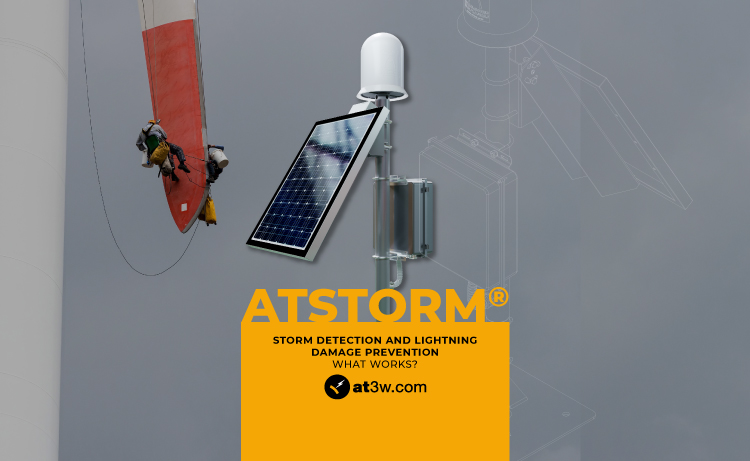The local detection of thunderstorms allows for the prevention of accidents derived from lightning strikes. Electrical storms can cause death and injury to people. The risk is increased for workers in open spaces. In addition to the loss of life and health, lightning strikes damage properties, infrastructures, industries, communication systems and cultural heritage. Lightning starts many wildfires, causes power line failures, and can also cause environmental disasters.
The implementation of prevention and protection measures against lightning has continuously reduced the number of people killed or injured by lightning strikes. Preventive measures are temporary actions that are started when the lightning risk alert is received and are deactivated once the danger has passed. Some examples are the evacuation of personnel and stopping or postponing dangerous activities, etc.
To take these temporary measures, a reliable storm detection system1 should be available. Next, we will break down the types of detectors that exist, their advantages and disadvantages, and, above all, if they are valid for preventive purposes.
Detectors based on monitoring of the electromagnetic field: what are they for?
Detectors based on monitoring of the electromagnetic field measure the electromagnetic radiation produced by lightning. That is, they need a first download, either cloud-cloud or cloud-ground, to issue their lightning strike risk alert. For this reason, these systems are used for the analysis of past events, but they are not always suitable for taking preventive measures.
Detectors based on monitoring of the electromagnetic field have traditionally been used to locate thunderstorms. One of these current electromagnetic detectors (also known as LLS, Lightning Location System) must be able to record in different categories all cloud-ground lightning strikes of any polarity and cloud-cloud discharges, and also to locate them within a determined area2. In addition, these storm detectors can measure the intensity and type of lightning, and even track storm cells and the evolution of the electrical charge structure in real time3,4.
Storm detectors based on electromagnetic field are not always suitable for preventive purposes, especially in cases where the storm forms just above the target to be protected.
LLS base their lightning strike hazard alarm on the distance between the previous discharges and the target to be protected. In this way, they assume that a discharge close to the area to be protected implies that the following lightning will be produced in that area. If the discharge occurs further away, it would entail a lower risk of lightning striking the target. However, if the first thunderstorm discharge occurs on the same target, there will be no prior alarm and no necessary preventive actions will be taken.
According to a 20055 study, 54% of the victims affected by lightning did not receive notice of the threat because there was no lightning strike prior to the impact for 20 km around. On other occasions, there were fewer than 3 lightning bolts during a 2-minute period before the person was struck by the lightning, so victims did not have enough reaction time to seek appropriate shelter.
Electromagnetic field vs electrostatic field
Unlike storm detectors based on electromagnetic field, electrostatic field sensors are capable of detecting the formation of electrical storms over the area to be protected and, therefore, of issuing the risk alarm with an adequate anticipation time to take preventive actions.
In the IEC 62793: 2020 standard on Storm Warning Systems, four phases are established in the evolution of an electrical storm:
- Phase 1: Elevation of the electrostatic field.
- Phase 2: Intra-cloud and cloud-cloud discharges, although cloud-ground can also occur.
- Phase 3: Cloud-cloud and cloud-ground downloads.
- Phase 4: Decrease in the download rate.
Electromagnetic field-based storm detectors can detect phases 2, 3, and 4 but not phase 1. They can locate long-distance storms where discharges are already occurring.
Electrostatic field-based detectors are the only ones that detect all phases of the storm, since the measurement of the atmospheric electrostatic field is the only direct and unequivocal indicator of the risk of a lightning strike before it occurs. Detection by local electrostatic field measurement provides the only robust preventive protection, as it monitors the gradual formation of a thunderstorm, from the initial phase to good weather, as defined in IEC 62793: 2020.
Furthermore, electromagnetic field-based storm detectors use a countdown from the last detected discharge to determine that there is no risk of lightning strike: if no discharge occurs within a certain time limit, the alarm is ended. However, there may be cases where the risk is still present and a shock occurs just after the defined time limit, or even the alarm lasts longer than necessary, which can lead to significant financial losses.
Detection by local electrostatic field measurement provides the only robust preventative protection, as it monitors the gradual formation of a thunderstorm, from the initial phase to good weather, as defined in IEC 62793: 2020.
Ultimately, the only system that provides the risk of a real lightning strike are storm detectors based on the measurement of the electrostatic field, which can detect all phases of the storm, indicating both its formation or approach and its dissipation or distance. Electrostatic field sensors allow the adoption of preventive measures acting on the basis of the objective measurement of the environmental electrostatic field.
The detectors based on electromagnetic field, on the other hand, since they base their risk alarm on the proximity or distance of a previous discharge, they are not always useful for preventive purposes, although they do allow locating and analyzing lightning once they have struck.

ATSTORM®, the best of both technologies
ATSTORM®, developed and patented by Aplicaciones Tecnológicas, is a local alert system for the prevention of risk of electrical storms. It consists of electrostatic field sensors, fully electronic and without moving parts. The storm detection system can perceive electric field fluctuations from storms forming over the target and / or active storms up to a radius of 20 km. This technology provides several minutes of anticipation before the first lightning strike could be detected by reading the electromagnetic field.
ATSTORM® bases its alert on the measurement of the electrostatic field, although it also has an electromagnetic sensor that expands its monitoring area and allows defining a pre-alert status.
ATSTORM® also incorporates an electromagnetic sensor as a complement to monitor the approach of the storm up to a radius of 40 kilometers. In this way, the monitoring area is extended and a pre-alert status notice can be defined in the event of distant active storms approaching the target to be protected.
Preventing accidents due to lightning is possible when you have a storm detector that offers reliable and accurate information at all times of the risk of storms forming or approaching the target.
You can download the full article here.
For more information on thunderstorm detection and lightning strikes accidents prevention, you can contact our team of experts at this link.
References:
- Tamborero, J. M. & Polo, S. NTP-1.084: Prevention of occupational hazards caused by lightning strikes. (2017).
- Rakov, V. A. Electromagnetic Methods of Lightning Detection. Surv. Geophys. 34, 731-753 (2013).
- Cooper, M. A. & Holle, R. L. Reducing Lightning Injuries Worldwide. Springer Natural Hazards (2019).
- Nag, A., Murphy, M. J., Schulz, W. & Cummins, K. L. Lightning locating systems: Insights on characteristics and validation techniques. Earth and Space Science vol. 2 65–93 (2015).
- Lengyel, M. M., Brooks, H. E., Holle, R. L. & Cooper, M. A. Lightning casualties and their proximity to surrounding cloud-to-ground lightning. 85th AMS Annu. Meet. Am. Meteorol. Soc. – Comb. Prepr. 3185-3191 (2005).
